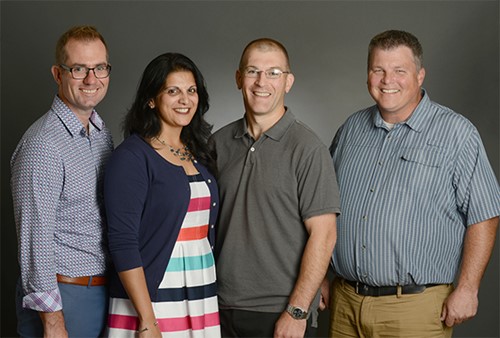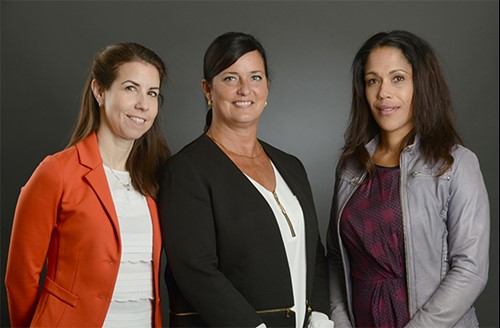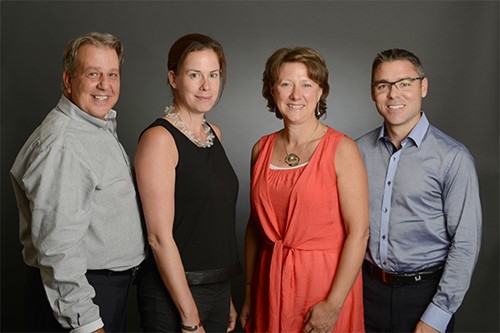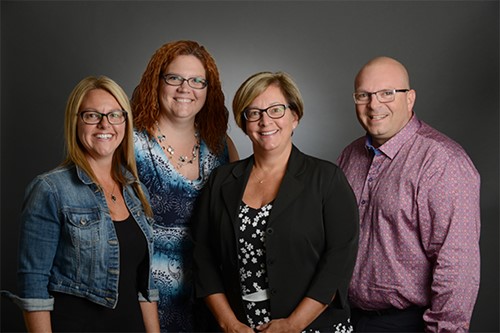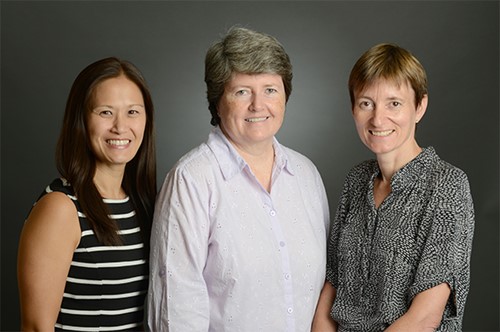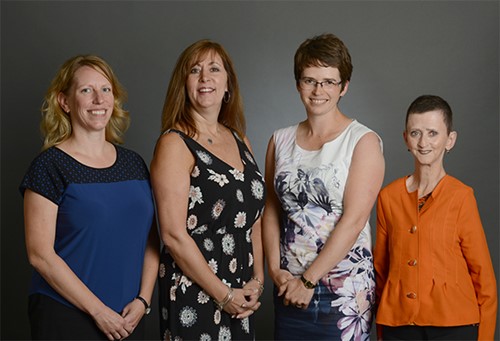2016 EXTRA Improvement Projects
Canadian Armed Forces (Federal)
- Richard Hannah, Director, Force Health Protection, 1 Canadian Air Division Surgeon / 1 Canadian Air Division HQ, Canadian Armed Forces - CF Health Services, Winnipeg, Manitoba
- Scott Malcolm, Director, Force Health Protection, Canadian Armed Forces - CF Health Services, Ottawa, Ontario
- Gordon Peckham, Commanding Officer / CF Health Services Centre Pacific, Canadian Armed Forces - CF Health Services, Victoria, British Columbia
- Shoba Ranganathan, Chief Quality and Patient Safety Officer / Health Services Delivery, Canadian Armed Forces - CF Health Services, Ottawa, Ontario
Periodic Health Assessment Renewal
The periodic health assessment (PHA) is used to determine operational fitness (including exams required by regulations, e.g. for Aircrew), occupational and environmental health hazard exposure screening, and primary prevention/health promotion measures necessary for each member of the Canadian Armed Forces (CAF).
The current PHA is cumbersome, not evidence-based, and fails to accomplish all of its established purposes. The improvement project is focused on revising the PHA to make it evidence based and ensure it addresses its core requirements. This is critical as the PHA in its present form is time intensive yet fails to completely capitalize on an opportunity to improve the overall health of CAF personnel.
The first phase of the improvement project will focus on the revision of the PHA based on the examination of the current PHA process where numerous problem areas have already been highlighted. Analysis of the core requirements through the engagement of patients and stakeholders, in addition to the review of best practices and evidence will allow for the refinement of the PHA process and assist in determining whether single or multiple processes are necessary in order to fully address the core requirements of the PHA.
The second phase of the project will evaluate the implementation of the revised PHA process in meeting the core requirements. It is anticipated that PHA renewal will positively affect areas such as compliance, appropriateness and utilization of diagnostic tests, and the long-term prevention of disease onset and/or progression. The PHA process will be tested and refined as required to ensure that it is achieving the stated aim and positively impacts the overall health of the CAF population.
Centre intégré de santé et de services sociaux Laval (Québec)
- Marina Larue, Directrice des soins infirmiers, Centre intégré de santé et de services sociaux de Laval, Laval, Québec
- Isabelle Legault, Adjointe à la présidente-directrice générale adjointe, Centre intégré de santé et de services sociaux de Laval, Laval, Québec
- Ève Riopel, Directrice médicale adjointe à la direction des services professionnels, Centre intégré de santé et de services sociaux de Laval, Laval, Québec
Implementing and Sustaining the Practice of Levels of Care
This project consists in helping physicians and healthcare teams integrate, into their practice, discussions with patients and their families, on care targets in serious illness or end-of-life situations. Although quality care requires that the patient’s needs and preferences be taken into account, often, in end-of-life care, their needs are not known. The practice of levels of care seeks to open up dialogue and give thought to a patient’s needs should a situation arise when it is no longer possible to obtain his or her consent. This enables patients to constantly play a role in the process they are involved in. It has been demonstrated that, despite a desire expressed by patients for this type of process, levels of care are not sufficiently alluded to by healthcare professionals. Beyond the positive impact on the patient and his or her family, it has been noted that the assessment of levels of care also has a beneficial impact on the number of hospitalizations and resource utilization.
It is, therefore, our objective to enable as many patients as possible with advanced chronic health issues to benefit from discussions on levels of care thanks to the creation and implementation of an institutional policy. Targeted training, information and promotion interventions will be set up in order to maximize integration of this practice in the healthcare services currently offered at CISSS Laval. Attempts will be made to get as many healthcare teams onboard as possible. The impact on the quality of care will also be assessed.
Centre intégré de santé et de services sociaux Montérégie-Centre / Centre intégré de santé et de services sociaux Montérégie-Ouest (Québec)
- Nathalie Bérard, Directrice adjointe au DSP et mécanismes d'accès, Centre intégré de santé et de services sociaux de la Montérégie-Centre, Greenfield Park, Québec
- Pierre Guay, Directeur des programmes santé mentale et dépendance, Centre intégré de santé et de services sociaux de la Montérégie-Ouest, Châteauguay, Québec
- Dominique Pilon, Directeur des programmes jeunesse et des activités de santé publique, Centre intégré de santé et de services sociaux de la Montérégie-Ouest, Châteauguay, Québec
- Cloé Rodrigue, Adjointe au directeur de la recherche, Centre intégré de santé et de services sociaux de la Montérégie-Centre, Greenfield Park, Québec
Structuring the Integration of Pharmacists in FMGs
In Quebec, more than 40% of the population is part of a Family Medicine Group (FMG), where they receive primary care. The new FMG Management Framework foresees a funding allocation enabling these groups to enter into service agreements with Community pharmacists.
Harmful side effects of medication and failure to comply with medical treatments are a direct cause that increasingly contributes to treatment failure, Emergency Department visits and hospitalizations. The integration of Community Pharmacists into FMGs is, therefore, an excellent lever to enhance the care our population receives.
While working together with the main stakeholders (pharmacists, physicians, nurses and patients), the team would (1) suggest ways of guaranteeing a smooth integration of community pharmacists into the FMG; (2) identify a range of relevant services to maximize the participation of pharmacists in the healthcare process; (3) promote a population-centric approach enabling FMGs to customize the services they offer to the needs of their clientele; and (4) draw up an implementation plan, and an assessment of said plan, to facilitate the integration of pharmacists into Family Medicine Groups in the Montérégie area.
In the long run, the idea is to provide appropriate, needs-centric services as well as the expertise of pharmacists, physicians, nurses, social workers and other healthcare professionals in Family Medicine Groups, thereby maximizing the potential of this type of collaboration and the resources used.
Centre intégré de santé et de services sociaux Montérégie-Ouest (Québec)
- Philippe Besombes, Directeur de soins infirmiers et enseignement universitaire, Centre intégré de santé et de services sociaux de la Montérégie-Ouest, Châteauguay, Quebec
- Mélanie Dubé, Directrice adjointe qualité, évaluation, performance et éthique, Centre intégré de santé et de services sociaux de la Montérégie-Ouest, Châteauguay, Québec
- Mitchell Germain, Médecin, Centre intégré de santé et de services sociaux de la Montérégie-Ouest, Vaudreuil, Québec
- Vincent Veilleux, Directeur des services techniques, Centre intégré de santé et de services sociaux de la Montérégie-Ouest, Châteauguay, Québec
Development of support for palliative homecare services
The aim of the CISSSMO (Centre intégré de santé et de services sociaux de la Montérégie-Ouest) improvement project is to offer palliative care and end-of-life support for clients who have expressed the desire to die at home.
The problem may seem quite simple, but it involves a number of challenges linked to accessibility, safety and coordination of care and services; more specifically the accessibility and availability of medical and professional resources. The lack of support for the patient’s caregivers can also be a major obstacle during the last moments of at-home end-of-life care services.
We intend on using the many strengths of our organisation to overcome these major issues, which impede the last wishes of the terminally ill. For instance, we will draw upon our expertise in the field of online client monitoring thanks to the implementation of novel services such as Tele-Care and Tele-Monitoring. We will also be able to leverage the interdisciplinary expertise of professionals and community organisations specializing in palliative care.
To summarize, we are convinced that the efforts and energy invested in this major project will enable patients in end-of-life situations to carry out their wishes to die at home. Fulfilling the wishes expressed by clients and families in an atmosphere of dignity and respect will be the focal point of the care we provide.
Centre intégré universitaire de santé et de services sociaux de Capitale Nationale / Centre hospitalier universitaire de Québec Université Laval (Québec)
- Nancy Drouin, Directrice adjointe programme soutien à l'autonomie des personnes âgées, CIUSSS Capitale Nationale et CHU de Québec Université Laval, Québec, Québec
- Lucille Juneau, Directrice adjointe programme soutien à l'autonomie, CIUSSS Capitale Nationale et CHU de Québec Université Laval, Québec, Québec
- Brigitte Martel, Directrice soins infirmiers, CHU de Québec Université Laval, Québec, Québec
Transitioning Seniors from their Home Environment to a Hospital Setting
Seniors often have multiple comorbidities due to the coexistence of a multitude of chronic illnesses, cognitive decline and/or physical disability. They often have to consult many clinicians in different settings, which can lead to the fragmentation of care and inefficiencies in healthcare services. Seniors are significantly affected by a breakdown in the continuum of care, namely transition points. A number of problems which have been observed stem from the absence of continuity of care, i.e. duplication of assessments and investigations, inappropriate treatments, unnecessary delays in the healthcare process and even a breakdown in care which can undermine the elderly person’s integrity at a time when they are already in such a weakened state. These transitions require adaptation on the part of the elderly, a need to relearn self-care and a need to reorganize daily life in order to acquire and preserve their autonomy. Interventions on the part of different healthcare professionals can support the elderly in their recovery. Working with seniors and their loved ones, this project aims to set up frontline interventions and measures in a hospital setting with a view to promoting smooth transitions. Experimentation with outcome measures will be carried out with elderly persons living in the National Capital Region (NCR) and within Laval’s Teaching Hospital in Quebec City. A continuous improvement plan will enable the transfer of evidence-based interventions to other areas of the NCR.
Centre intégré universitaire de santé et de services sociaux de Centre-Ouest-de-l'île-de-Montréal (Québec)
- Sébastien Bilin, Centre Intégré Universitaire santé et services sociaux du Centre-Ouest de l'île-de-Montréal, Montréal, Québec
- Marie-Hélène Carbonneau, Directrice-adjointe des soins infirmiers, Centre Intégré Universitaire santé et services sociaux du Centre-Ouest de l'île-de-Montréal, Montréal, Québec
- Christine Touchette, Directrice adjointe Soutien à l'autonomie des personnes âgées, Centre Intégré Universitaire santé et services sociaux du Centre-Ouest de l'île-de-Montréal, Côte St-Luc, Québec
Management and Tracking of the Chronic Illness Pathway by the Patient and the Multidisciplinary Team using Tele-Care
This project aims to achieve three (3) main goals:
1.1 Developing an inventory of what is currently being used in the Integrated Centre with respect to technology and chronic illnesses and, where possible, create linkages between projects.
1.2 Setting up a Technological Projects Assessment Committee before and during utilization (on which sits one or more patients) and creating a standardized indicator measurement grid.
1.3 Establishing a means of determining user and stakeholder satisfaction with respect to the use of said technological tools (where users would be involved).
Centre intégré universitaire de santé et de services sociaux de Saguenay-Lac-St-Jean (Québec)
- Roberto Boudreault, Chef du département régional de médecine générale, Centre intégré universitaire de santé et de services sociaux du Saguenay-Lac-Saint-Jean, St-Félicien, Québec
- Isabelle Boulianne, Adjointe aux affaires universitaires, Centre intégré universitaire de santé et de services sociaux du Saguenay-Lac-Saint-Jean, Chicoutimi, Québec
- Nancy Houde, Chef de service en soins infirmiers - Continuum clinique, Centre intégré universitaire de santé et de services sociaux du Saguenay-Lac-Saint-Jean, Chicoutimi, Québec
- Sylvie Massé, Directrice des soins infirmiers, Centre intégré universitaire de santé et de services sociaux du Saguenay-Lac-Saint-Jean, Jonquière, Québec
Patient Experience: A Common Understanding of the Transition Toward Palliative Care
Considered a chronic illness, cancer has been the primary cause of mortality for fifteen (15) years in Saguenay-Lac-Saint-Jean and is responsible for 35 % of the deaths observed annually in the area. The number of new cancer cases and deaths continue to increase significantly in the region.
The transition from curative care to palliative care is often a traumatic experience for patients and families. As for healthcare professionals, they often lack training, are poorly equipped and do not know when it is a good time to broach the subject patients. However, the earlier palliative care is integrated into the care of patients with incurable chronic illnesses, the better. Moreover, when this is offered, the quality of life and the survival rate of patients increase and symptoms of depression decrease.
Based on the experience of patients and families, as well as that of professionals in the field, our team would like to acquire a common understanding of the clinical transition from curative to palliative care. In order to do this, people living with incurable chronic illnesses will be questioned about various aspects of their palliative care experience. Healthcare professionals who work the most with this type of clientele will also be interviewed.
Acquiring better knowledge of the true needs of patients and healthcare professionals with respect to their experience is our starting point. Indeed, basing interventions and actionable strategies on real and felt needs, on an enhanced continuum of care, on treatments that are better suited to the situation and on better coaching will more than likely facilitate the transition from curative care to palliative care.
The Ottawa Hospital (Ontario)
- Jessica Dy, Division Head and Quality Medical Lead, Division of Obstetrics and Gynecology, Ottawa Hospital, Ottawa, Ontario
- Laura Hopkins, Deputy Chair, Department of Obstetrics and Gynecology and Head, Division of Gynecologic Oncology, Ottawa Hospital - General Campus, Ottawa, Ontario
- Ann Mitchell, Director of Obstetrics, Gynecology and Newborn Care at the Ottawa Hospital, and Director of Neonatal Services at the Children’s Hospital of Eastern Ontario, Ottawa, Ontario
Improving Patient Outcomes and Experience in Women Requiring Labour Induction
Induction of labour is a common procedure and occurs in ~ 25% of all births, or just over 1,500 women per year, at The Ottawa Hospital. Most women who undergo labour induction often require 24-48 hours of pre-induction cervical preparation prior to the onset of labour. Evidence suggests that patient experience is better and health care cost reduced when this process is carried out in an outpatient setting. Currently at The Ottawa Hospital, most women undergoing induction of labour are admitted to the birthing unit. This scenario utilizes acute 1:1 nursing care, prolongs women’s hospital length of stay, and creates a level of anxiety and frustration among women. This project aims to find safe and cost-effective solutions that will accommodate the nursing and monitoring needs of women requiring pre-labour cervical ripening without needing an inpatient admission to the birthing unit. Specifically, we will obtain baseline data regarding (1) proportion of women requiring inpatient labour induction (2) patient satisfaction among women undergoing inpatient labour induction (3) length of stay and cost per weighted case of inpatient labour induction. An alternative pre-induction care pathway will be created for women meeting specific criteria and implemented at The Ottawa Hospital. This new process is expected to decrease inpatient hospital stay by 24-48 hours, enhance patient experience in women needing an induction of labour, and reduce cost per weighted case for low risk vaginal births.
Nova Scotia Health Authority (Nova Scotia)
- Erin Christian, Manager, Planning & Development, Primary Health Care, Nova Scotia Health Authority, Halifax, Nova Scotia
- Crystal Todd, Chief Family Medicine, Western Zone, Nova Scotia Health Authority, New Minas, Nova Scotia
- Cheryl Tschupruk, Provincial Palliative Care Coordinator, Cancer Care Nova Scotia, Nova Scotia Health Authority, Halifax, Nova Scotia
- Jo-Anne Wentzell, Director, Primary Health Care, Chronic Disease Management, Family Practice (Western Zone), Nova Scotia Health Authority, Berwick, Nova Scotia
Integrating a Palliative Approach in Primary Health Care
Early access to palliative care is shown to improve patient and family outcomes. Primary care providers are often the first and most consistent points of contact in the health system. Their role in palliative care is essential as we move toward collaborative team-based care in the primary health care (PHC) system in Nova Scotia.
As palliative care evolved into a specialty, primary care providers have cared for individuals requiring palliative care less; therefore, competency and confidence in PHC has decreased. Specialty services are designed to offer expertise to compliment comprehensive and continuous care provided in the health home and is not intended to sustain comprehensive care or address individuals’ needs over time. With all team members working together (primary care, specialties, and community resources) no one person is overburdened and individuals requiring palliative care remain in their familiar health surroundings.
In 2014, the NS Department of Health and Wellness released a provincial palliative care strategy with recommendations guiding the health system toward an integrated model of palliative care rooted in PHC. The IP will use an engagement process with PHC team(s) exhibiting high readiness to change to develop, test, and refine an operational framework to integrate a palliative approach into PHC settings in NS, changing the model for delivering a palliative approach to care. Anticipated outcomes include enhancing access to appropriate care; building capacity in primary care; optimizing existing resources; role clarity in palliative care; and improving patient/family experience, ultimately resulting in quality palliative care for all Nova Scotians.
Providence Care / Kingston General Hospital / South East Community Care Access Centre (Ontario)
- Brenda Carter, Vice President, Cancer Services and Diagnostic Imaging; Regional Vice President (RVP), South East Regional Cancer Program, Kingston General Hospital, Kingston, Ontario
- Laurie French, Senior Manager, Client Services, South East Community Care Access Centre
- Jenn Goodwin, Senior. Director, Community Relations & Strategy, Providence Care KGH South East, Kingston, Ontario
- Natalie Kondor, Palliative Medicine physician / Regional Lead, Palliative Care, Kingston General Hospital, Kingston, Ontario
The Kingston Model: Improved access through centralized intake
Our project focuses on establishing a centralized point of intake for patients who are referred for palliative care services, regardless of the care environment or care provider(s). Our target population will be patients with lung, pancreatic and colorectal cancer.
A centralized intake will support referrals made by a patient/patient advocate, primary care provider or specialist provider (eg. oncologist), based on the result of the “surprise question” (Gold Standard Framework1[1]). Once received, an initial assessment using validated tools such as the Edmonton Symptom Assessment Score (ESAS) and the Palliative Performance Scale (PPS) can be completed by allied health professionals.
We see several possible positive outcomes:
- Increased opportunity to educate patients/families on the role of Palliative Care earlier in the disease trajectory;
- Patients/families will have an increased ability to self-refer and access palliative care services;
- Shared access to intake documentation will lead to more timely access to appropriate services, increase collaboration/communication between service providers, and allow patients to remain with their primary care providers for longer;
- Real-time updates to a patient’s condition at intake and reassessments, enabling earlier identification of patients who need intensive palliative involvement;
- Establishing a central intake will build upon resources (human and technology) that already exist in Kingston, and improve quality of care and satisfaction for patients/ families;
- Early referrals and coordinated care planning can lead to reduced visits to the Emergency Department by patients receiving palliative care services and better use of system resources overall.
[1] RCGP, GSF Prognostic Indicator Guidance, http://www.goldstandardsframework.org.uk/cd-content/uploads/files/General%20Files/Prognostic%20Indicator%20Guidance%20October%202011.pdf
